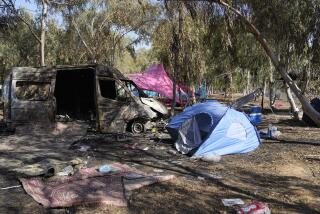So Rape Isn’t Hatred? : Law: To exclude from prosecution acts committed against women would be a mockery of discrimination legislation.
- Share via
Last December, a man walked into the engineering school at the University of Montreal armed with a hunting rifle. He entered a classroom and divided the students he found there into two groups: women and men. Shouting at the women, “You’re all a bunch of feminists,” he picked them off as if they were ducks in a shooting gallery. By the time he had finished his deadly stalk, he had killed 14 women and injured many others. A note found in his pocket after he had killed himself declared that women had ruined his life.
The man in Montreal killed these women because he hated them--not as individual persons, but as women. The law in this country would not, however, consider these murders crimes of hate.
We have come to use the term hate crime to refer to a crime committed not out of animosity toward the victim as an individual, but out of hostility to the group to which the victim belongs. The attack in Howard Beach, in which one black man was killed and two were beaten by white assailants, is one of the most notorious examples in recent years.
Some states have enacted laws specifically directed at hate crimes. California, for example, requires the collection and analysis of statistics on hate crimes. Other states either elevate a crime such as second-degree assault to first-degree assault where the assault was motivated by the victim’s membership in a particular group or establish a separate crime such as “ethnic intimidation.”
Recently enacted legislation directs the federal government to gather statistics on such crimes.
None of these laws include gender as one of the motivating characteristics that can turn an ordinary crime into a crime of hate. The new federal law, for example, considers hate crimes to be those impelled by the victim’s race, ethnicity, religion or sexual orientation. Other, similar laws recognize as crimes of hate only those motivated by the victim’s race, color, creed, religion or national origin.
Thus, if a woman is beaten, raped or killed because she is a woman, this is not considered a crime of hate.
“Race, color, religion, sex and national origin” has become a kind of refrain in our laws against discrimination. These characteristics invariably appear together as the forbidden criteria for the allocation (or withdrawal) of benefits such as education, employment and housing. One must, therefore, do a double-take when reading a discrimination statute that does not include gender as one of the forbidden bases for conduct.
The reason for this exclusion cannot be that there is no problem. The special risk faced by women in this country because they are women cannot be denied. We have learned to order our lives according to this special danger, so much so that when we refuse thus to arrange our lives, we are held equally as accountable as our aggressor for any injury that results.
Nor can the reason for failing to recognize some acts against women as hate crimes be that it is impossible to differentiate between those crimes and “ordinary crimes.” We do not worry about this evidentiary snag in declaring that crimes motivated by the victim’s race, creed or national origin are hate crimes. Indeed, one of the purposes of the new federal statute is to establish a method for identifying crimes of hate.
We are not, it is true, accustomed to thinking of crimes against women in the same way that we think of racial or ethnic violence. We tend, instead, to treat brutalizing acts against women either as isolated cases--that is, as events brought about by some specific characteristic or conduct of the victim--or, in rare cases, as manifestations of racial or ethnic hatred.
Thus, in searching for the reason why a group of boys brutalized a jogger in Central Park last spring, virtually everyone turned to race; the boys were black, the woman was white. But another white jogger in the park that night--a man--was also beaten, was not raped, was not, in short, treated as if he were less than human. It is at least curious, therefore, that people did not seize upon the one feature distinguishing the two runners--gender--and declare that a catalyst for the boys’ most savage crime.
This hesitation in pronouncing an act victimizing a woman a crime of hate is no reason not to pronounce it so. Indeed, this hesitation may be a symptom of the very pathology that produces such a crime. To deny that the outrages committed in Montreal are crimes of hate is to defy the facts, and to deny such acts our censure is to signal that crimes committed against women because they are women do not trouble us very much. That is a message welcome to no one but the misogynist.
More to Read
Sign up for Essential California
The most important California stories and recommendations in your inbox every morning.
You may occasionally receive promotional content from the Los Angeles Times.













